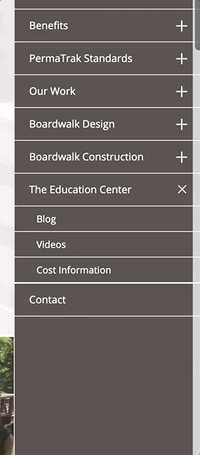- Find your company/products when they visit Google searching for information
- Learn about the key features and benefits of your product(s) or offerings
- See examples and testimonials of past projects and work
- Review content that demonstrates how your business, products, and offerings are unique, and how they help solve a problem
In order to help visualize this content, pull up your website next to your biggest competitor’s website and ask yourself these questions:
- Which website conveys more credibility?
- Which one showcases a high end, quality product, making it fun and exciting to see that product in action?
To ultimately close sales, your marketing efforts need to help the business shine brighter than competitors with similar products. You can make sure that it does just that by arming your website with these four features. To illustrate, we’ll include specific examples from PermaTrak, a precast concrete boardwalk company and a happy Craft Impact client.
A brag-worthy blog
Many assume that having a company blog means posting every week and stocking a content calendar with topics for the next year. While some businesses may have the resources to go this route, this simply isn’t possible for most, particularly in the manufacturing or construction material industry, where traveling, trade shows, product demos and in office sales presentations are the lifeblood of the sales strategy.
But committing to a blog that is consistently updated with relevant and helpful information for your buyers is a foundational component of great SEO (search engine optimization). Following SEO best practices is an important tactic for driving more organic traffic to your website, which means you can outrank your competition in online search results.
If your business doesn’t have the resources to manage this on its own, you’ll need to weigh the pros and cons of hiring outside help. Depending on your company’s goals for the website and blog, this could be anywhere from hiring a part-time college student to a marketing company that will partner with you to bring expertise to the table and help manage the workload.
Start small and go outside of “company updates”
 Think of your team as your built-in expert panel. Your employees are knowledgeable about your business and products, so assign colleagues a blog post on topics that run the gamut of the business (the articles don’t need to be lengthy; aim for 300-600 words). Commit to posting once every six to eight weeks or so. Having an active blog on your website with new content a few times a year demonstrates that you’re a bustling business with interesting news to share.
Think of your team as your built-in expert panel. Your employees are knowledgeable about your business and products, so assign colleagues a blog post on topics that run the gamut of the business (the articles don’t need to be lengthy; aim for 300-600 words). Commit to posting once every six to eight weeks or so. Having an active blog on your website with new content a few times a year demonstrates that you’re a bustling business with interesting news to share.
Most importantly, try to push beyond the new projects and hire announcements. While these are worthwhile topics, you can differentiate from your competition by crafting blog articles that truly address the pain points and challenges of your buyers, positioning your company as a thought leader.
When you compare your site vs. the competition, ask yourself, “Which website gets right to the point and answers the questions prospects are asking your sales reps on a daily basis?”
For an example, check out PermaTrak’s blog, which contains various topics like design and construction information, cost comparisons with the competition, featured designers and project updates.
Organized website pages
Your website is the digital gateway for customers to interact with your company. It should be a true reflection of your business. In under 10 seconds, a website visitor should be able to understand how your product is different from the competition and addresses their challenge. Make it easy on them to find what they’re looking for - both with a prominent search option and a straightforward navigation menu.
 When considering which pages to add (or how to change up your existing menu pages), aim for between four to six options in the navigation menu. Why? Having too many options at the top may be confusing for someone simply trying to locate the headquarters address and phone number. Having too few options leaves the visitor with no easy way to find out more about your company.
When considering which pages to add (or how to change up your existing menu pages), aim for between four to six options in the navigation menu. Why? Having too many options at the top may be confusing for someone simply trying to locate the headquarters address and phone number. Having too few options leaves the visitor with no easy way to find out more about your company.
Keep the titles short
Simple titles make it easier to navigate the web page. Consider the graphic on the right - notice how PermaTrak’s page headers are one to three words long with an option to click on the plus sign for additional drop downs pages. Organized and functional, these make it easy for the visitor to quickly scan the options to find answers to their questions in just a few clicks. Find the balance between being informative and easy-to-navigate, and your visitors will thank you!
Blogging and improving your website navigation may seem daunting, but small changes can make a huge difference! If you're ready for more, drop us a line - we'd love to talk to you!
